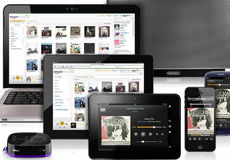By
emeadowsMarch 29, 2013
Amazon’s X-Ray feature, which uses the company’s IMDb database of content to add real-time actor information to Amazon’s Instant Video service, will expand to include TV show viewing, the company announced on Wednesday. To start, the X-Ray feature will be available for 13 shows including popular hits like “Downton Abbey,” “The Walking Dead,” “Breaking Bad” and “Game of Thrones.” Amazon and IMDb are working to expand the service. Continue reading X-Ray: Actor ID Feature from Amazon Expands to TV Shows
By
emeadowsMarch 26, 2013
When the fourth season of NBC’s “Community” aired in February, it pulled in 4 million viewers, which is roughly a quarter of the audience that tunes in to top hit sitcoms. Until recently, Nielsen numbers in that range might be the end of a series (think “Firefly,” “Jericho,” “Freaks and Geeks”). But on the night of the “Community” premiere, the show spawned two worldwide trending topics via Twitter — perhaps a more important metric today. Continue reading Should Nielsen Change How it Measures TV Audiences?
By
Rob ScottMarch 14, 2013
With the launch of Vevo TV — a 24-hour live stream of curated programming — Vevo has taken an additional step toward becoming a full-fledged music television network. The new channel uses MTV-like VJs and is available on the Web and mobile devices, as well as via Roku boxes and Xbox 360 gaming consoles. Looking ahead, the company hopes to take Vevo TV to cable distributors and have it compete with the likes of MTV and VH1. Continue reading Vevo TV Streaming Music Platform is All About Devices
Wired reviews Western Digital’s new WD TV Play, describing it as a capable set-top box priced for the money conscious consumer — but only gives the $70 media player a rating of 6 out of 10 (“a solid product with some issues”). The Play will have to work hard to stand out, since it faces stiff competition from the $100 Apple TV and $80 D-Link MovieNite Plus and Roku 2, which all offer 1080p playback and array of streaming services. Continue reading WD TV Play: Affordable Media Player from Western Digital
By
Rob ScottFebruary 4, 2013
Apple is in negotiations to carry Time Warner’s HBO GO app on its Apple TV by mid-2013, say two people familiar with the matter. Apple’s $99 set-top device already streams content from Netflix and Hulu Plus. With the addition of HBO GO, the STB could better compete with video-delivery devices such as Roku and Microsoft Xbox (which already have the HBO service). Continue reading Insiders Suggest HBO GO Could Be on Apple TV by Mid-Year
By
Carolyn GiardinaJanuary 13, 2013
Six new Roku Ready partners — Coby Electronics, Harman Kardon, Hisense, TCL, Voxx Accessories and Westinghouse Digital — have joined existing partners so that future devices from these companies will be certified as “Roku Ready,” meaning they’ll come MHL-ready for Roku’s compact Streaming Stick. The stick now offers more than 700 channels of streaming entertainment. Continue reading CES 2013: Roku Announces New Slate of Roku Ready Partners
By
Rob ScottDecember 17, 2012
Amazon’s cloud-based music storage and streaming service is now available on Roku and Samsung’s Smart TVs, allowing users to play digital music on a single device. The app “finally gives Roku a good response to Apple TV’s iTunes Match,” notes CNET. Months ago Roku announced that the Amazon Cloud Player was “coming soon.”
 Like its competitor iTunes Match, Amazon Cloud Player charges $25 per year to store up to 250,000 songs. It also includes a feature that automatically identifies music files and upgrades the quality using a 256 Kbps file from the Amazon catalog. “That’s a ton of digital music, although the competing Google Play Music allows you to store up to 20,000 tracks for free and is available on Google TV devices,” explains the post.
Like its competitor iTunes Match, Amazon Cloud Player charges $25 per year to store up to 250,000 songs. It also includes a feature that automatically identifies music files and upgrades the quality using a 256 Kbps file from the Amazon catalog. “That’s a ton of digital music, although the competing Google Play Music allows you to store up to 20,000 tracks for free and is available on Google TV devices,” explains the post.
The release was announced the same day that Amazon added its Amazon Instant Video app for the iPhone and iPod touch.
According to a related post from CNET, the Instant Video streaming app “allows for access to over 140,000 movies and television shows that can be downloaded for purchase or rental.”
Amazon offers access to its streaming library across devices including the iPad, Kindle Fire HD, PlayStation 3, PCs and Macs. The app is only available to customers who pay for the company’s $79-a-year Prime membership.
By
David TobiaDecember 14, 2012
Playcast is a cloud-based gaming service that runs through pay TV, IPTV, or over-the-top TV providers like Google TV and Roku.
 “For the end user, the system operates like VOD or an app, while remote servers actually run the games and stream a video feed of the gameplay in real-time,” reports Engadget. “On the back end, one server shelf can serve up to 15 players an HD (read: 720p) feed simultaneously, and graphical artifacting is kept to a minimum because it streams over the operator’s managed network.”
“For the end user, the system operates like VOD or an app, while remote servers actually run the games and stream a video feed of the gameplay in real-time,” reports Engadget. “On the back end, one server shelf can serve up to 15 players an HD (read: 720p) feed simultaneously, and graphical artifacting is kept to a minimum because it streams over the operator’s managed network.”
Playcast differentiates itself from OnLive because Playcast can brand its front-end interface to fit specific customers’ desires and does not need additional hardware. Playcast also offers packages of games for subscription use.
The company plans to launch in Q3 of 2013 with 10-15 packages of 20 games each. The packages will likely cost $10-$15 a month. Playcast will alternate 10 percent new games in each month to keep customers engaged.
“It appears that Playcast will provide casual gamers an intriguing option for getting their gaming fix next year,” concludes the post. “But we’re reserving judgment until we see how well the games run on a managed network, what titles are offered, and just how much it’ll cost.”

